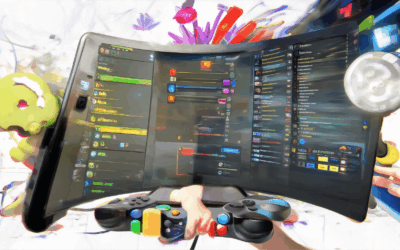Game distribution platforms have become the backbone of the modern gaming industry, shaping how developers, publishers, and players connect across the globe. These platforms not only facilitate the sale of games but also influence the entire ecosystem, from independent creators to multinational corporations. With the rise of digital distribution, platforms like Steam, Epic Games Store, and others have redefined how games are discovered, purchased, and played. In this article, we explore the largest online game distributors, the mechanics of game distribution, and the future trends that promise to revolutionize the industry further. From understanding the role of cloud gaming to examining the revenue models of top platforms, this comprehensive guide will provide insights into how these platforms continue to shape the gaming world.

What is the Largest Online Game Distributor?
The largest online game distributor is Steam. Steam, owned by Valve Corporation, has become the leading platform for distributing digital games, particularly on PC. It initially focused on selling the right to play games from independent developers and major publishers, which has expanded its library significantly over the years.
Key Reasons for Steam’s Dominance:
- Broad Game Library : Steam offers a vast selection of games, ranging from AAA blockbusters to niche indie titles, attracting a diverse audience.
- Frequent Sales and Discounts : Regular promotions and discounts make Steam an attractive option for cost-conscious gamers.
- Cross-Platform Availability : While primarily known for PC, Steam has expanded to include consoles, mobile devices, and virtual reality platforms through initiatives like Steam Deck.
- Community Features : Steam provides robust community features, including user reviews, discussions, and workshops, which foster engagement among users.
Competitors:
While Steam leads the market, other notable platforms include:- Xbox Game Store : Microsoft’s platform for Xbox console games.- PlayStation Store : Sony’s store for PlayStation games.- Nintendo eShop : Nintendo’s digital store for Switch games.- Apple App Store and Google Play : Dominant in mobile gaming.
Each of these platforms caters to specific hardware ecosystems, but Steam’s widespread adoption and cross-platform strategy give it a competitive edge.
Subscription Services:
Steam also offers subscription services like Steam Deck, providing monthly games, though this competes with platforms like Xbox Game Pass and PlayStation Plus, which focus more on game access rather than distribution.
Global Reach:
Steam’s global presence, supported by localized pricing, payment options, and language support, contributes to its appeal. Despite competition, Steam remains a favorite among gamers due to its extensive library and frequent sales.
By combining accessibility, affordability, and a diverse game library, Steam continues to be the leading choice for many gamers worldwide.
Game Distribution
Game distribution refers to the process through which video games are delivered to players. This can occur either physically via retail stores or digitally through various online platforms.
Types of Game Distribution
- Physical Distribution: Games are sold in physical formats such as cartridges, discs, or Blu-ray/DVDs. This method is commonly used for console games and often includes special editions with collectibles.
- Digital Distribution: Games are distributed electronically via the internet. This method allows for instant access and is widely used for PC games, mobile apps, and streaming services.
History of Game Distribution
- Early forms of distribution involved arcades and rental services in the 1980s.
- Home consoles like the Nintendo Entertainment System (NES) popularized physical distribution in the late 1980s and early 1990s.
- Digital distribution began to gain traction in the mid-2000s with platforms like Steam and Xbox Live.
Current State of Game Distribution
- Digital distribution dominates due to the convenience and accessibility it offers.
- Cloud gaming services like NVIDIA GeForce NOW and Xbox Cloud Gaming are reshaping how games are accessed.
- Subscription-based models (e.g., Xbox Game Pass, PlayStation Plus) are becoming increasingly popular.
- Independent (Indie) developers rely heavily on digital platforms to reach audiences.
Resources for Indie Developers
Indie Dev Games is a valuable resource for independent developers looking to understand and navigate the complexities of game distribution. Our platform offers guides, reviews, and insights to help developers choose the right distribution method for their needs.
For more information about game distribution and its impact on the gaming industry, visit our website at Indie Dev Games .

The Best Platform to Sell Video Games
Selling video games can be done through various platforms, each with its own advantages and drawbacks. Here’s a comparison of the most popular options:
- Amazon : Known for its vast audience and reliable payment system, Amazon allows sellers to set their own prices. However, they charge higher fees compared to other platforms.
- eBay : Offers lower fees and a broader audience. It’s ideal for selling both new and used games, though managing individual listings can be time-consuming.
- GameStop : Primarily a physical retailer, but they accept trade-ins for used games. This is a good option if you’re looking to sell games locally or in-store.
- Facebook Marketplace/Craigslist : Great for local sales and connecting with nearby buyers. Ideal if you prefer face-to-face transactions.
- Etsy : Suitable for unique or collectible games, though it’s less common for standard titles.
- Reddit Communities : Platforms like r/gaming can be effective for reaching a niche audience, though it requires active participation in the community.
To maximize your sales, consider the following steps:
- Research Your Audience : Understand who your target buyers are and choose platforms that cater to their preferences.
- Create Attractive Listings : Use high-quality images and detailed descriptions to attract potential buyers.
- Optimize Pricing : Set competitive prices based on market trends to maximize your selling price.
- Use Reliable Payment Methods : Ensure the platform offers secure payment options to build trust with buyers.
- Advertise Strategically : Leverage platform features like eBay’s “Promot” tool or Amazon’s advertising options to increase visibility.
By evaluating these platforms and strategies, you can choose the one that aligns best with your goals and preferences.

What Percentage Does Epic Take From Game Sales?
Epic Games charges developers 12% of the revenue generated from games sold through the Epic Games Store. This revenue model is part of what makes the platform attractive to developers, offering a competitive rate compared to other platforms. Below is a breakdown of how this percentage is calculated and its implications for game developers:
- Revenue Share: 12% of gross sales revenue.
- Pricing Flexibility: Developers set their own prices, but Epic takes a fixed percentage from each sale.
- Global Reach: The platform’s widespread availability helps increase potential revenue streams for developers.
Competitor Comparison
While Epic’s 12% rate is competitive, it’s important to consider alternatives. Platforms like Steam , Xbox Game Store , PlayStation Store , and Nintendo eShop offer similar revenue models, each with their own unique benefits and structures.
Additional Revenue Streams
Epic also generates income through other ventures, including in-game purchases, ads, and subscriptions. These streams contribute to the company’s profitability without directly impacting the revenue share for developers on the Epic Games Store.
Resources for Indie Developers
For indie developers looking to maximize their revenue potential, platforms like Indie Dev Games provide valuable resources and insights. This hub offers tutorials, reviews, and tips tailored to help developers create successful games and thrive on various platforms, including the Epic Games Store.
Company Ownership
Tencent owns 40% of Epic Games.
The ownership stems from Tencent’s acquisition of a 48.4% stake in Epic Games in 2012, which later decreased to 40% due to the issuance of employee stock options. This deal was part of a larger agreement where Tencent provided financial support to Epic in exchange for equity.
- Unity Technologies
- Valve Corporation
- Other competitors in the game development space

Does Steam Take 30% of Sales?
Yes, Steam typically takes a standard cut of 30% from each game sale.
Revenue Share Context
Steam’s revenue model is structured to take a significant portion of sales, which is a common practice among digital distribution platforms. This 30% fee applies to most games sold on Steam, though special arrangements may be made for certain titles or promotional periods.
Alternatives and Market Context
While Steam dominates the market, other platforms like the Epic Games Store and the Microsoft Store often offer higher revenue shares for developers, typically ranging from 70% to 90%. However, Steam remains a preferred platform due to its extensive user base and established ecosystem.
Factors Influencing Revenue Share
The exact revenue share can vary based on several factors, including the type of game, promotional deals, and volume discounts for high sales volumes. Developers interested in maximizing their earnings often explore these options carefully.
Conclusion
In summary, Steam takes a 30% cut from most game sales, aligning with industry standards for digital distribution. While alternative platforms may offer better rates, Steam’s widespread adoption makes it a crucial consideration for many developers.




0 Comments